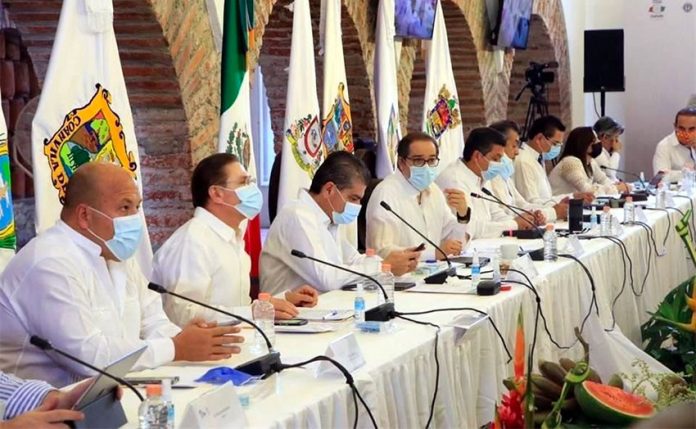Jalisco Governor Enrique Alfaro was one of several state leaders to voice their dissatisfaction with the federal government’s new “stoplight” map which paints most of the country red, the maximum state of risk for the coronavirus.
In the 31 federal entities designated red — only Zacatecas achieved a better ranking — only essential activities will be permitted.
Publication of the map, which will be updated weekly, comes as federal coronavirus social distancing guidelines are set to be lifted on Saturday.
In a press conference Friday, Jalisco Governor Enrique Alfaro questioned the federal government’s criteria, methodology and intentions. He declared that it was “absurd” that his state should be given a red designation when only one of the four indicators was red.
Those indicators are the number of active and new coronavirus cases, hospital admission trends and hospital occupancy levels. When the system was announced, Deputy Health Minister Hugo López-Gatell explained that if a state scored red on any one indicator during a given week it would be given the red designation.
Alfaro, who also claimed that federal officials had not invited state input into the designations as planned, joins the governors of Colima, Michoacán, Durango, Nuevo León, Coahuila and Tamaulipas in rejecting the traffic light classifications.
“We express our disagreement with and rejection of a red light that does not reflect the reality of our states. On the contrary, it seems that it has a political purpose, to hold the states responsible for the dead,” said Michoacán’s Silvano Aureoles Conejo after the seven governors met Friday in Colima.
The states are taking various approaches to easing coronavirus restrictions, weighing the balance between economic recovery and the risk of higher levels of infection and making decisions independent of the federal government.
The newspaper El Universal reported today what Monday’s “new normal” will look like in states that have announced plans for a partial reopening.
- Aguascalientes: Some businesses will reopen but not movie theaters, bars, nightclubs or gyms.
- Baja California: The automotive, aerospace, construction and mining sectors will reopen.
- Baja California Sur: Government offices, construction and mining will start up again, but tourism will not and no date has been agreed upon.
- Campeche: Construction businesses can resume operations.
- Chiapas: Although the government continues to advocate for stay-at-home measures, some businesses opened up anyway last week, and restaurants and bars in San Cristóbal de las Casas announced they will reopen as of Monday.
- Chihuahua: The government says 30% of businesses will reopen on June 1 and follow health protocols.
- Coahuila: Partial reopenings will take place in the automotive, restaurant and other business sectors.
- Durango: Only the mining and construction industries will go back to work.
- Guanajuato: Some government offices will reopen, as will 30% of shoe and leather businesses. Plazas and shopping malls will partially reopen.
- Guerrero: The mining and construction industries will return to work.
- Jalisco: Nonessential businesses will reopen.
- Michoacán: Economic activity will resume on a partial basis.
- Nayarit: The mining and automotive industries will start up again.
- Queretaro: The aerospace, automotive and construction industries will reopen and follow health guidelines.
- Quintana Roo: The state will open for tourism on June 8.
- Nuevo León: The mining, construction, aerospace, automotive, beer and hotel industries will reopen.
- San Luis Potosí: Some businesses will partially reopen, with priority given to the manufacturing sector.
- Sinaloa: Businesses and services will gradually reopen. Decisions on opening up the tourism sector will be made on a regional level.
- Tamaulipas: Around 25% of nonessential businesses will reopen.
- Yucatán: Construction businesses will be allowed to get back to work.
- Zacatecas: Some businesses and government offices will reopen.
Source: El Universal (sp)
